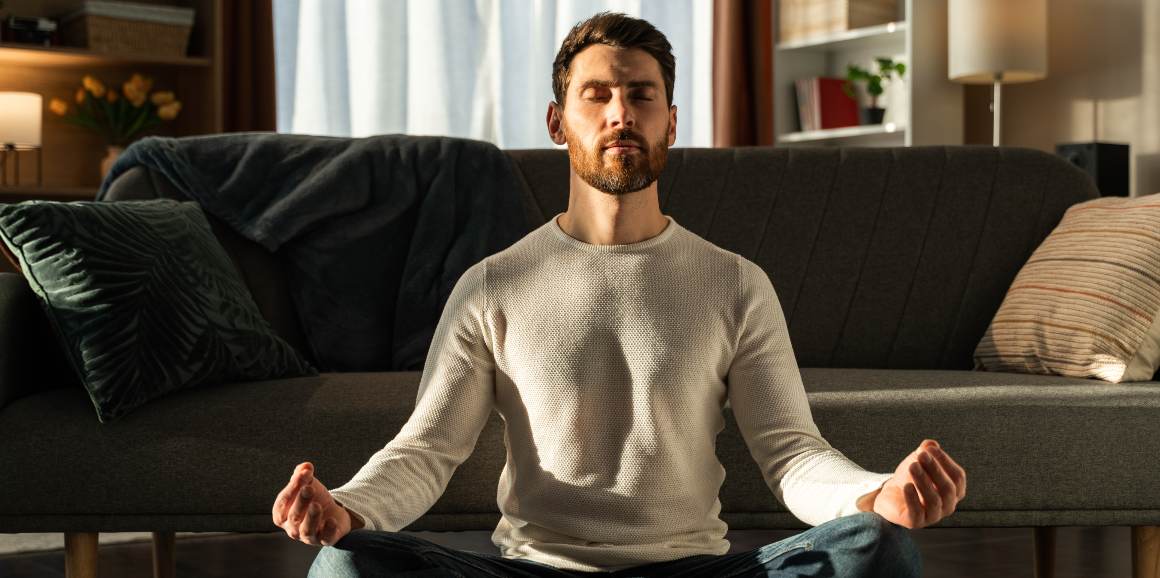Visualization to Calm Nervous System
Published:
Visualization is a powerful relaxation technique that can help calm the nervous system and reduce anxiety. It involves using your imagination to create calming and peaceful images in your mind. By focusing on serene scenes such as a beach, forest, or mountaintop, you can induce a sense of relaxation and ease. Visualizing yourself achieving goals and visualizing compassion towards yourself and others can also help alleviate anxiety. Other relaxation techniques such as breathing exercises, yoga, and meditation can also be effective in calming the nervous system. Regular practice of visualization can improve its effectiveness in reducing anxiety and promoting a sense of calm. If anxiety symptoms persist, it is important to seek support from a primary care doctor or mental health professional.
Contents:
- Key Takeaways:
- Understanding the Power of Visualization
- Techniques for Effective Visualization
- Guided Visualizations for Relaxation
- Visualizing Compassion for Anxiety Relief
- Visualizing Goals for a Calmer Mind
- Enhancing Visualization with Breathing Exercises
- Yoga and Visualization for Mental Wellness
- Meditation and Visualization for Inner Peace
- The Power of Regular Visualization Practice
- Conclusion
-
FAQ
- Q: How does visualization help calm the nervous system and reduce anxiety?
- Q: Are there specific scenes or images that work best for visualization?
- Q: How often should I practice visualization for anxiety relief?
- Q: Can visualization be combined with other relaxation techniques?
- Q: When should I seek professional support for my anxiety symptoms?
- Source Links

Key Takeaways:
- Visualization is a powerful relaxation technique for calming the nervous system and reducing anxiety.
- By using your imagination to create peaceful images, you can induce a sense of relaxation and ease.
- Visualizing goals and practicing compassion can also alleviate anxiety.
- Combining visualization with other relaxation techniques like breathing exercises, yoga, and meditation can enhance their effectiveness.
- Regular practice of visualization can improve its ability to reduce anxiety and promote calmness.
Understanding the Power of Visualization
By visualizing calmness and engaging in visualization exercises, you can effectively calm your mind and soothe your nervous system. Visualization is a powerful relaxation technique that taps into the mind's ability to create peaceful imagery. When you imagine serene scenes such as a beach, forest, or mountaintop, you activate your brain's relaxation response, leading to a sense of ease and tranquility.
Research has shown that visualization can be an effective tool for reducing anxiety. By picturing yourself achieving your goals or visualizing compassion towards yourself and others, you can alleviate stress and promote emotional well-being. These visualization techniques help shift your focus away from worry and anxiety, allowing you to cultivate a sense of calmness and inner peace.
Enhancing your visualization practice with other relaxation techniques can further amplify its benefits. Breathing exercises, such as deep breathing and diaphragmatic breathing, can enhance the relaxation response and synergize with visualization. Incorporating yoga postures and meditation into your visualization practice can also contribute to a calmer mind and reduced stress levels.
Regular practice is key to reaping the full benefits of visualization. The more you engage in visualization exercises, the more effective they become in soothing your nervous system and reducing anxiety. Consistency is key, and incorporating visualization into your daily routine can lead to long-lasting stress reduction and a greater sense of well-being.
| Benefits of Visualization for Calming the Nervous System: |
|---|
| Reduces anxiety and stress |
| Promotes relaxation and ease |
| Cultivates a calmer mind and inner peace |
| Fosters compassion, both towards yourself and others |
| Enhances the effectiveness of other relaxation techniques |
In conclusion, visualization exercises provide a powerful means to calm your mind and soothe your nervous system. By incorporating techniques such as visualizing calmness, achieving goals, and cultivating compassion, you can alleviate anxiety and promote relaxation. Complementing your visualization practice with breathing exercises, yoga, and meditation further enhances its benefits. Remember to make visualization a regular part of your routine, as consistent practice is essential for maximizing its effectiveness. Should your anxiety symptoms persist, it is important to seek support from a healthcare professional.
Techniques for Effective Visualization
There are various visualization tools available that can aid in managing anxiety and promoting relaxation. When it comes to effective visualization, it's important to find techniques that resonate with you and create a sense of calm. One popular technique is creating a mental sanctuary, where you imagine yourself in a peaceful and serene environment. This could be a beach, a forest, or any place that brings you a sense of tranquility. By visualizing the sights, sounds, and even smells of your sanctuary, you can transport yourself to a state of relaxation.
Another technique is using guided imagery, where you listen to a recorded script that guides you through a visualization exercise. Guided visualizations often focus on specific themes, such as stress reduction, healing, or self-compassion. These scripts can be found online, in apps, or even through mental health professionals. By following the guidance and visualizing the scenarios described, you can tap into the power of your imagination and create a calm space within.
Visualization Tools for Anxiety Management
In addition to these techniques, there are tools that can enhance your visualization practice. One such tool is a vision board, which is a collage of images and words that represent your goals, desires, and aspirations. By creating a vision board and regularly visualizing yourself achieving these goals, you can motivate and inspire yourself, ultimately reducing anxiety and promoting a sense of purpose.
Another tool is the use of affirmations, which are positive statements that you repeat to yourself. By visualizing these affirmations as you say them, you can reinforce positive beliefs and calm your anxious mind. For example, if you're feeling stressed, you can visualize the words "I am calm and at peace" while repeating this affirmation.
Ultimately, the key to effective visualization is finding what works best for you. Experiment with different techniques and tools to discover the ones that resonate with you and bring you the most peace. Remember, visualization is a practice, so consistency is key. By incorporating visualization into your daily routine, you can harness its benefits and manage anxiety effectively.
| Technique | Description |
|---|---|
| Mental sanctuary | Imagining yourself in a peaceful and serene environment to induce relaxation. |
| Guided imagery | Listening to recorded scripts that guide you through visualization exercises. |
| Vision board | A collage of images and words representing your goals and aspirations. |
| Affirmations | Positive statements repeated while visualizing to reinforce positive beliefs. |
Guided Visualizations for Relaxation
Guided visualizations have a powerful impact on calming the nervous system and promoting relaxation. By engaging in guided visualization exercises, individuals can tap into their imagination and create a soothing mental landscape that helps alleviate anxiety and stress. These guided visualizations are designed to guide the mind to a state of calmness and peace, allowing for a sense of tranquility to wash over the body.
During a guided visualization session, individuals are led through a series of imagery and prompts that encourage deep relaxation. This can involve imagining oneself in a serene setting, such as a peaceful garden or a secluded beach, where the mind can wander and find solace. By focusing on the details of these scenes, from the gentle rustling of leaves to the warmth of the sun on the skin, individuals can transport themselves to a place of tranquility and escape the turmoil of everyday life.
In addition to providing a mental escape, guided visualizations also engage the senses and help individuals connect with their emotions. By visualizing compassion and sending positive energy to oneself and others, individuals can foster a sense of empathy and understanding. This compassionate visualization can not only reduce anxiety but also promote a greater sense of well-being and connectedness.
| Benefits of Guided Visualizations for Relaxation |
|---|
| Calms the nervous system |
| Promotes deep relaxation |
| Reduces anxiety and stress |
| Fosters empathy and compassion |
By incorporating guided visualizations into daily routines, individuals can reap the benefits of a calm and relaxed nervous system. Whether through professionally guided recordings or self-guided visualizations, the power of these mental journeys can bring about profound relaxation, leading to a greater sense of well-being and inner peace.
Visualizing Compassion for Anxiety Relief
Visualizing compassion towards yourself and others can be a powerful technique for reducing stress and anxiety. When we practice compassion, we cultivate a sense of deep understanding and kindness towards ourselves and those around us. This practice can help us let go of negative self-judgment and develop inner peace.
Incorporating visualization techniques into your compassion practice can enhance its effectiveness. Start by finding a quiet and comfortable space where you can relax without any distractions. Close your eyes and take a few deep breaths, allowing your body to relax with each exhale. Visualize a peaceful scene, perhaps a serene garden or a tranquil lake. As you immerse yourself in this imagery, imagine sending waves of compassion and love towards yourself, visualizing them as a warm, healing light enveloping your entire being.
Expand your visualization to include others. Picture someone who is experiencing stress or anxiety in your mind's eye. Send them waves of compassion and love, seeing them surrounded by the same warm, healing light that you imagined for yourself. Feel the connection and understanding between you grow, knowing that you are not alone in your struggles. Visualize this compassion spreading out to encompass all beings, creating a ripple effect of peace and serenity.
| Visualization Techniques for Stress Reduction |
|---|
| Imagine yourself in a calm and peaceful environment, such as a beach, forest, or mountaintop. |
| Visualize yourself achieving your goals and experiencing a sense of calm. |
| Practice breathing exercises and combine them with visualization for enhanced relaxation. |
| Incorporate visualization into your yoga routine for mental wellness and stress reduction. |
| Combine visualization with meditation to cultivate inner peace and tranquility. |
Remember to be patient with yourself as you practice visualizing compassion. It may take time and consistent effort to develop this skill. Don't be discouraged if your mind wanders or if you find it challenging at first. By nurturing compassion within yourself and extending it to others, you can create a powerful tool for reducing stress and anxiety.
If anxiety symptoms persist or become overwhelming, it is important to seek support from a primary care doctor or mental health professional. They can provide guidance, resources, and additional techniques to help you manage your anxiety effectively.
Visualizing Goals for a Calmer Mind
Visualizing your goals and envisioning success can contribute to a calmer mind and reduced anxiety levels. By mentally picturing yourself achieving your aspirations, you can tap into the power of visualization to create a positive outlook and a sense of confidence.
One effective technique is to create a vision board. This visual representation of your goals can serve as a constant reminder of what you are working towards. Include images, words, and phrases that evoke the emotions and aspirations associated with your goals. Display the vision board in a prominent place where you can see it regularly, allowing it to reinforce your motivation and keep you focused.
Table: Examples of Visualizing Goals
| Goal | Visualization Technique |
|---|---|
| Improved Fitness | Picture yourself completing a challenging workout with strength and ease. Feel the rush of endorphins and the satisfaction of achieving your fitness goals. |
| Career Advancement | Imagine yourself confidently presenting in front of a room full of colleagues and superiors. Visualize the success and recognition that comes with achieving your career goals. |
| Enhanced Creativity | Visualize yourself in a beautiful, inspiring environment, surrounded by colors, textures, and sounds that stimulate your creativity. Feel the flow of creative energy as it effortlessly guides your work. |
Another helpful technique is guided visualization. Guided visualizations are recordings or scripts that direct your imagination towards a specific goal or state of mind. You can find a wide range of guided visualizations available online or from qualified practitioners. These guided sessions can provide structure and guidance in your visualization practice, making it easier to focus and connect with your desired outcomes.
Remember, while visualization can be a powerful tool, it's important to combine it with consistent action towards your goals. By visualizing success and taking steps towards achieving it, you can cultivate a calmer mind, greater confidence, and a sense of fulfillment.
Enhancing Visualization with Breathing Exercises
Combining visualization techniques with breathing exercises can maximize their effectiveness in reducing stress and promoting a calmer nervous system. Breathing exercises are a powerful tool for relaxation, as they stimulate the body's natural relaxation response and help regulate the autonomic nervous system. When paired with visualization, breathing exercises can deepen the sense of calm and strengthen the mind-body connection.
One effective breathing exercise to practice alongside visualization is diaphragmatic breathing. This technique involves breathing deeply into the diaphragm, rather than shallowly into the chest. It can be done by sitting or lying down in a comfortable position, placing one hand on your chest and the other on your abdomen. Inhale deeply through your nose, allowing your abdomen to rise as you fill your lungs with air. Exhale slowly through your mouth, feeling your abdomen fall as you release the breath. As you practice diaphragmatic breathing, focus on syncing your breath with your visualization, allowing the imagery to flow effortlessly with each inhale and exhale.
Table: Diaphragmatic Breathing Technique
| Step | Description |
|---|---|
| 1 | Find a comfortable position, sitting or lying down. |
| 2 | Place one hand on your chest and the other on your abdomen. |
| 3 | Inhale deeply through your nose, allowing your abdomen to rise. |
| 4 | Exhale slowly through your mouth, feeling your abdomen fall. |
Another breathing technique that pairs well with visualization is the 4-7-8 breath. This technique involves inhaling for a count of 4, holding the breath for a count of 7, and exhaling for a count of 8. It can be particularly effective in promoting relaxation and reducing anxiety. To practice the 4-7-8 breath, sit in a comfortable position and close your eyes. Inhale slowly through your nose as you count to 4 in your mind. Hold your breath for a count of 7, and then exhale slowly through your mouth for a count of 8. Repeat this cycle several times, allowing your visualization to align with the rhythm of your breath.
By incorporating breathing exercises into your visualization practice, you can create a harmonious and synergistic effect that enhances your relaxation experience. Whether you choose diaphragmatic breathing, the 4-7-8 breath, or another technique that resonates with you, remember to approach your practice with patience and consistency. Over time, you'll find that the combination of visualization and breathing exercises become a valuable tool for reducing stress and cultivating a calmer mind.
Yoga and Visualization for Mental Wellness
Integrating visualization techniques into your yoga practice can contribute to improved mental wellness and stress reduction. By combining the power of visualization with the physical and meditative aspects of yoga, you can enhance your ability to calm the mind and soothe the nervous system.
During your yoga practice, consider incorporating visualization exercises to create a deeper sense of relaxation and focus. As you move through each pose, visualize yourself in a peaceful setting, such as a tranquil beach or a serene forest. Imagine the gentle breeze caressing your skin, the soothing sound of waves crashing, or the soft rustling of leaves. Allow these images to transport you to a place of calmness and serenity.
By aligning your breath with your movements and visualizations, you can amplify the benefits of both practices. As you inhale, visualize yourself inhaling positive energy and exhaling any tension or stress. With each breath, feel a sense of release and surrender to the present moment. This synchronized rhythm of breath and visualization can help quiet the mind, promote a sense of inner peace, and reduce anxiety.
As you conclude your yoga practice, take a moment to reflect on the combined effects of visualization and movement. Notice any shifts in your mental state and how your body feels. Appreciate the power of visualization and its ability to bring about a greater sense of mental wellness and stress reduction.
| Benefits of Yoga and Visualization for Mental Wellness: |
|---|
| Enhanced relaxation and stress reduction |
| Improved focus and concentration |
| Promotion of a calm and serene mind |
| Increased self-awareness and introspection |
Remember, regular practice is key to experiencing the full benefits of visualization techniques in your yoga routine. Take the time to cultivate a consistent practice that aligns with your needs and preferences. If you find that your anxiety symptoms persist or worsen, it is important to seek support from a primary care doctor or mental health professional.
Meditation and Visualization for Inner Peace
Incorporating visualization techniques into your meditation practice can deepen your sense of inner peace and tranquility. By engaging your mind's eye during meditation, you can enhance your ability to relax and let go of anxiety. One effective visualization technique is to imagine being in a serene natural setting, such as a peaceful meadow or a tranquil waterfall. As you meditate, visualize yourself surrounded by the sights, sounds, and sensations of this calming environment. This imagery can help quiet the mind and promote a deep sense of inner peace.
Another visualization technique that can be beneficial during meditation is to visualize a gentle, warm light enveloping your body. Imagine this light filling every cell of your being, bringing a sense of calm and healing. This visualization can help release tension and promote a feeling of serenity and tranquility.
Visualization for Letting Go of Anxiety
"Visualization allows us to tap into the power of our imagination to create a state of relaxation and peace." - Dr. Sarah Johnson, Clinical Psychologist
Dr. Sarah Johnson, a clinical psychologist, explains, "Visualization allows us to tap into the power of our imagination to create a state of relaxation and peace." This technique can be particularly helpful for those struggling with anxiety. By visualizing yourself releasing anxious thoughts and worries, you can let go of tension and embrace a calmer state of mind.
When practicing visualization during meditation, it's important to create a quiet and comfortable space where you can fully immerse yourself in the experience. You may find it helpful to dim the lights, play soothing music, or use aromatherapy to enhance relaxation. The more you practice visualization during meditation, the more effective it can become in reducing anxiety and cultivating a sense of inner peace.
| Benefits of Visualization for Inner Peace |
|---|
| Reduces anxiety and stress |
| Promotes a sense of calm and relaxation |
| Enhances the meditative experience |
| Deepens the connection with oneself |
Visualization is a valuable tool for achieving inner peace and tranquility. By incorporating visualization into your meditation practice, you can tap into the power of your imagination to create a state of calm and relaxation. Whether you visualize serene natural scenes or immerse yourself in a warm light, the act of visualizing during meditation has the potential to reduce anxiety, promote a sense of calm, and deepen your connection with yourself.
The Power of Regular Visualization Practice
Regular practice is key to harnessing the full power of visualization techniques for stress reduction and calming the nervous system. By incorporating visualization into your daily routine, you can cultivate a deep sense of relaxation and inner peace. Whether you choose to visualize serene natural landscapes, visualize compassion towards yourself and others, or visualize the achievement of your goals, consistent practice allows you to fully immerse yourself in the therapeutic benefits of this technique.
One effective way to integrate visualization into your practice is by combining it with breathing exercises. As you visualize tranquil scenes or positive outcomes, focus on deep, slow breaths to enhance the relaxation response. This combination of visualization and controlled breathing can further calm the nervous system and release tension from the body.
Yoga is another practice that can complement visualization techniques. By incorporating visualization into your yoga routine, you can deepen your mind-body connection and enhance the overall benefits of both practices. As you move through the poses, visualize yourself flowing with ease and grace, allowing the visualization to guide you into a state of tranquility.
| Key Benefits of Regular Visualization Practice: |
|---|
| Reduces anxiety and stress levels |
| Promotes relaxation and calmness |
| Enhances focus and concentration |
| Boosts mood and overall well-being |
Meditation is another powerful tool that can be combined with visualization for optimal mental wellness. As you engage in meditation, incorporate visualization techniques to create a peaceful internal landscape. Visualize yourself surrounded by tranquility, letting go of any stress or worries. This combination allows you to cultivate a deep sense of inner peace and serenity.
Remember, consistency is key when it comes to visualization practice. Set aside a dedicated time each day to engage in visualization exercises, even if it's just for a few minutes. Over time, you will start to notice the positive effects on your mental and emotional well-being. If anxiety symptoms persist or become overwhelming, it's important to seek support from a primary care doctor or mental health professional who can provide further guidance and assistance.
Conclusion
Visualization is a powerful technique that offers a multitude of benefits for calming the nervous system and promoting mental well-being. By using your imagination to create calming and peaceful images in your mind, you can induce a sense of relaxation and ease. Focusing on serene scenes like a beach, forest, or mountaintop can transport you to a tranquil state and reduce anxiety.
Visualizing your goals and envisioning yourself achieving them can also be a helpful tool in alleviating anxiety. By picturing success and progress, you can cultivate a calmer mind and a sense of confidence in your abilities. Additionally, visualizing compassion towards yourself and others can foster feelings of empathy and understanding, further reducing anxiety.
Combining visualization with other relaxation techniques such as breathing exercises, yoga, and meditation can enhance their effectiveness in calming the nervous system. These practices work synergistically to promote a sense of tranquility and inner peace. Regular practice of visualization can strengthen its impact and help you better manage anxiety in the long term.
If you continue to experience anxiety symptoms, it is important to seek support from a healthcare professional. A primary care doctor or mental health professional can provide guidance and assistance tailored to your specific needs. Remember, you don't have to face anxiety alone – there is help and support available to you.
FAQ
Q: How does visualization help calm the nervous system and reduce anxiety?
A: Visualization involves using your imagination to create calming and peaceful images in your mind. By focusing on serene scenes, you can induce a sense of relaxation and ease, which can calm the nervous system and reduce anxiety.
Q: Are there specific scenes or images that work best for visualization?
A: The scenes or images that work best for visualization vary from person to person. It can be a beach, forest, mountaintop, or any other peaceful and calming scene that resonates with you.
Q: How often should I practice visualization for anxiety relief?
A: Regular practice is key for effective visualization. Aim to practice visualization techniques daily or as often as needed to reduce anxiety and promote a sense of calm.
Q: Can visualization be combined with other relaxation techniques?
A: Yes, visualization can be combined with other relaxation techniques such as breathing exercises, yoga, and meditation. Combining these techniques can enhance relaxation and further soothe the nervous system.
Q: When should I seek professional support for my anxiety symptoms?
A: If your anxiety symptoms persist or significantly affect your daily life, it is important to seek support from a primary care doctor or mental health professional. They can provide appropriate guidance and treatment options.


















